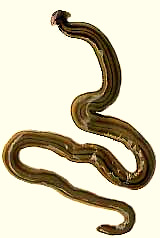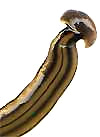Excerpts from Jim Conrad's
Naturalist Newsletter
from the December 16, 2001 Newsletter issued from the woods just south of Natchez, Mississippi, USA
MYSTERY WORM
 Sunday afternoon the plantation manager brought me a strange little worm in a Styrofoam tray that once had held a hamburger. The worm, shown at the right, was about eight inches long (20 cm), had been spotted crossing the sidewalk next to her house. It bore no legs so it was not a centipede or millipede, and it was not segmented, so it was not an annelid such as an earthworm. Its brownish flesh looked soft and rubbery like that of a snail but there were no antennae or a shell.
Sunday afternoon the plantation manager brought me a strange little worm in a Styrofoam tray that once had held a hamburger. The worm, shown at the right, was about eight inches long (20 cm), had been spotted crossing the sidewalk next to her house. It bore no legs so it was not a centipede or millipede, and it was not segmented, so it was not an annelid such as an earthworm. Its brownish flesh looked soft and rubbery like that of a snail but there were no antennae or a shell.
 However, the moment the worm raised its head, shown closer up at the left, and spread it as if it were a little cobra I knew what it was. It was a planarian, a member of the Flatworm Phylum, the best- known members of which are tapeworms -- of intestinal parasite fame.
However, the moment the worm raised its head, shown closer up at the left, and spread it as if it were a little cobra I knew what it was. It was a planarian, a member of the Flatworm Phylum, the best- known members of which are tapeworms -- of intestinal parasite fame.
Though I knew that our planarian would never affect us like its tapeworm relatives, its discovery caused me a bit of concern. This introduced species, BIPALIUM KEWENSE, is a native of Southeast Asia, from Vietnam to Kampuchea. It has invaded America by way of the soil of imported potted plants. In several US states the species has been reported in greenhouses, plus it's been found in the wild in Florida and Louisiana. As far as I can determine this could be its first discovery in the wild in Mississippi. Here they were surely introduced many years ago when the plantation owner was importing fancy plants from the Orient, something plantation owners in the old days did a great deal of.
One reason we studied planarians back in Zoology 100 was that they are such simple organisms. They lack any kind of lung, circulatory system (no heart, veins, arteries), they have no bones, and their digestive system is so basic that its mouth also serves as its anus. When it eats, using a strategy worthy of any science-fiction monster, it disgorges its muscular pharynx through is mouth, clamps down with it on a victim (earthworms, slugs and snails) and pulverizes its meal bit by bit. Food particles are brought into the planarian body and nutrients are dispersed through a simple three-branched intestine. Planarians possess ladder-shaped systems of nerves enabling incredible powers of regeneration. When zoology students slice them through the head to the middle of the body, in a few days each split develops its own head -- resulting in a two-headed planarian. This may not be as distressing to the animal as you would think. When a mature planarian gets long enough its rear end sticks to the ground, a narrowing develops somewhere on the worm's rear half, and the front end simply pulls away from the rear. The rear then sprouts a head and you have a new planarian.
The troubling part about our planarian is that often plants and animals introduced from elsewhere no longer are controlled by the natural enemies present in their own lands, and they overrun their new environment exactly as kudzu and fire ants have already done here. I would not like to see these planarians eating all our native earthworms, snails and slugs. I just am not sure how serious this discovery is.
from the November 30, 2003 Newsletter issued from the woods just east of Natchez, Mississippi, USA
LAND PLANARIANS AFTER A BIG RAIN
Above you see that in 2001 a land planarian, BIPALIUM KEWENSE, was called to my attention when I lived at Laurel Hill Plantation. Since Bipalium kewense is a native of Southeast Asia that has been introduced into the US by way of the soil of imported potted plants, I figured that the discovery was a very local find. I couldn't find any reports of it having been found in the wild in Mississippi.
Wednesday night we had another big rain, once again more than filling my three-inch-high tin cup. On Thanksgiving morning the ground was saturated, and that may be the reason I found three dark-brown Bipalium kewenses about five feet (1.5m) up the barn's exterior cinderblock walls. They were all curled into knotty, mucous-covered masses. If they had been stretched out, they would have extended six inches or so (15 cm). Clearly, this species is more common in our region than I had thought.
Land planarians are amazing creatures. They are members of the Flatworm Phylum, the best-known members of which are the tapeworms of intestinal parasite fame. They can reproduce sexually and lay eggs in cocoons, but the most frequent manner of reproduction is by "fragmentation." At a certain time, at a point about 0.4 inch (1 cm) from the worm's rear end, the worm's sides pinch in, and continue pinching in until the rear end simply breaks off. The rear end then goes one way and the main worm body goes another. Within seven to 10 days a head begins forming on the pinched- off end. One or two such fragments are released each month.
If you've taken a biology class, you may have conducted experiments on a planarian's nervous system. If you cut a planarian's head down the middle, lengthwise, a two-headed planarian my result. Sometimes if you just cut the head off a worm, a being will result consisting of nothing but two heads pointing in opposite directions, joined neck-to-neck.
Bipalium kewense eats earthworms, slugs, insect larvae and other planarians. I'm not sure how much of a threat this introduced species is to our native earthworm populations, but I doubt that they do them much good.